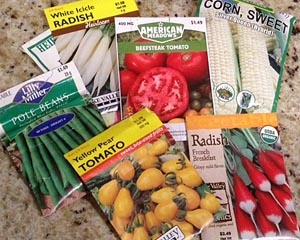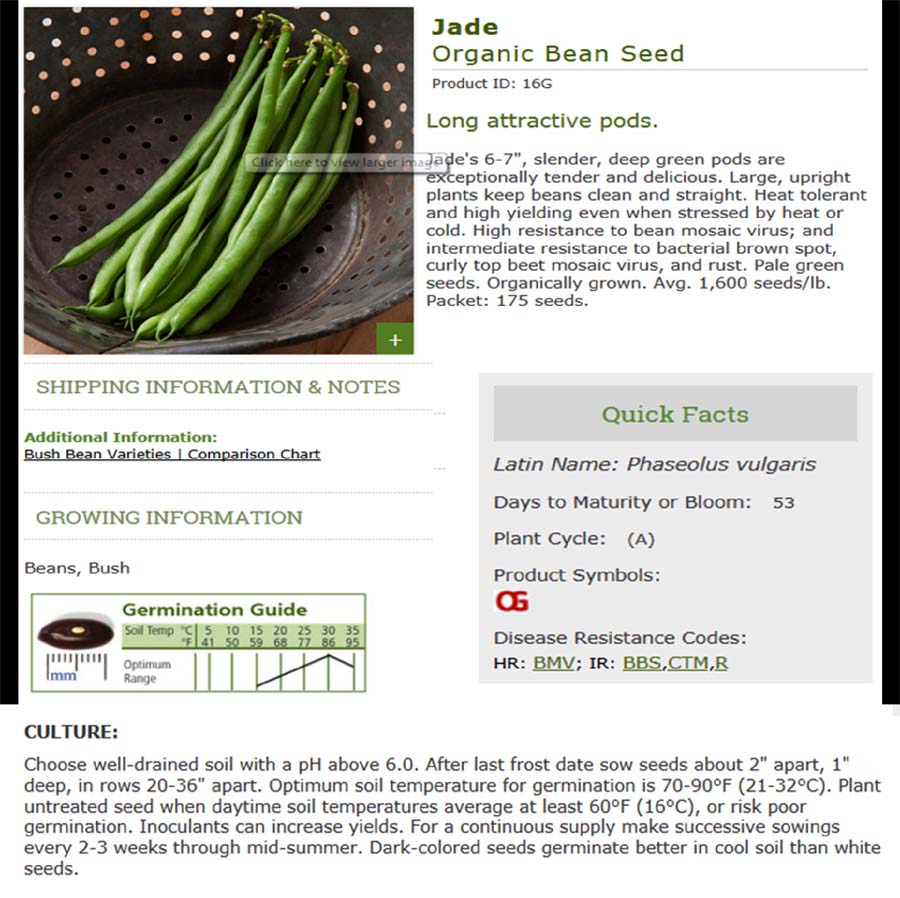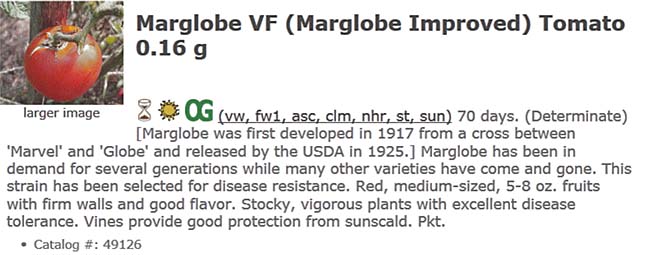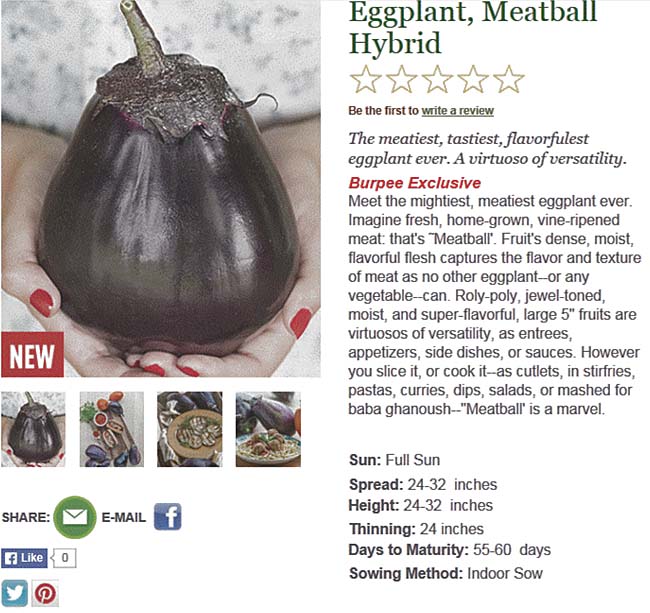How To Buy Vegetable Seeds From Catalogs
By Gil Medeiros, Fairfax Master Gardener
 Go ahead; look at the pictures first. They are, after all, part of the pleasure of browsing seed catalogs in January, when snowflakes are swirling outside your window. Just make sure that when it is time to buy seeds, your choices reflect more of what the catalogs say than what they show.
Go ahead; look at the pictures first. They are, after all, part of the pleasure of browsing seed catalogs in January, when snowflakes are swirling outside your window. Just make sure that when it is time to buy seeds, your choices reflect more of what the catalogs say than what they show.
Of course, seed catalogs come in two varieties these days — the paper ones and the online ones. Don’t limit yourself solely to the former. Seed companies do an excellent job of selling their wares online, and you can consult a large number of them quickly to decide which you like best.
Why buy seeds online or through the mail? Besides convenience, the reason is these sources offer a much better selection than the seed racks at local stores, allowing you to experiment to your heart’s content. What catalog/website should you use? There are many good ones; I highlight three in this article and list many more at the end.
Master gardeners, an advanced group as a whole, tend to favor seed catalogs that provide copious amounts of reliable information and offer many choices, including heirloom varieties and seeds harvested from organically grown plants. As a beginning gardener, however, your basic requirements for a catalog/website should be the quality of information given and the availability of many varieties. To guide you, here is some factors to consider when making seed selections. (This discussion assumes that your garden has at least six hours of direct sun, the minimum to grow vegetables).
- Quality
Flavor, size, appearance of edible crop, and did I mention flavor? Why go to the trouble of growing it in your backyard if you can buy the same mediocre vegetable in a store? You want to invest your time and effort in growing something better. Farmers often don’t grow the most flavorful varieties because the fruit does not ship well, or it is too expensive to grow profitably. In your backyard, these should not be factors. Flavor, however, is on the tongue and in the nose of the beholder. Be aware that most catalogs/websites describe flavor very generously. You will have to develop your own calibration of the advertising hyperbole. - Disease/insect resistance
You expect to lose some of your crop to pests, particularly if you practice organic gardening, but you would like a fighting chance for a reasonable return. Plant genetics are very important here. Hybrids are often bred for disease and insect resistance. Some heirloom varieties have these characteristics as well, but through natural selection, not plant breeding. Pay close attention to these disease-tolerance and resistance statements when you are making your selections. - Timing
When should I put plants or seeds out? How long before I can harvest? You don’t want to plant lettuce in June or beans in April. You don’t want to schedule your vacation for the time when the tomatoes will start ripening. Timing is critical. All catalog/websites have this information. - Size of plant, growth habit: Can I fit this plant into my limited space? Do I need to support it on stakes or a trellis?
- Heat and drought tolerance. This is often an indicator of where optimal results will be achieved. An important consideration is whether these plants stand the heat and humidity in the Middle Atlantic?
- Organic seed
If you are an organic gardener, it may be important to you to obtain seeds from plants that have been raised organically. - Other factors
- Treated seed
Some diseases are communicated through seeds. You might like to know if you can buy seed that has been treated to suppress various diseases. - Endorsements
If the variety is identified as an All America Selection (AAS), you can be confident it is a good performer in the garden. This is an independent, nonprofit organization that judges new varieties impartially. - Safe Seeds
Some gardeners look for assurance that companies are not selling genetically modified seed. Most catalogs offer this assurance these days.
- Treated seed
How these factors are weighed, compared and traded off is always a matter of personal preference, and your priorities may not be the same for all vegetables. In my garden, disease and insect resistance are very important for tomatoes, cucumbers and zucchini squash. But for peppers, flavor and yield are paramount. For beans, flavor and growth habit are key. For onions, my priority is whether they will grow here in Virginia, which is not an ideal place to grow onions. Note that flavor is important in every choice, but not the most important factor for all.
Here are some sample selections from three catalogs/websites that are popular among gardeners. In each case, make a mental note of the information categories that are included. Johnny’s Selected Seeds. This is my “go to” source for vegetable seeds.
Johnny’s Selected Seeds
This is my “go to” source for vegetable seeds.

This web page has everything you need to decide to try this bush bean (I have intentionally excluded pricing). There is even more here that I have not shown; it amounts to a manual on how to grow these beans. I have found this supplier’s flavor descriptions to be fairly reliable. The flavor descriptions are most useful when they are comparing varieties within a specific plant species, such as tomato.
Southern Exposure Seed Exchange
This company started as a seed exchange but is a true seed company now. One appealing advantage Southern Exposure has for the local gardener is that they raise most of the seed in Virginia, unlike Johnny’s, which is headquartered in Maine.

The hourglass symbol means this is an heirloom variety. The sun symbol means the variety will grow well in the South and Middle Atlantic. The OG symbol means the seeds come from organically grown plants. The abbreviations on the first line tell the buyer this has tolerance to verticillium wilt (vw); fusarium wilt, race 1 (fw1); alternaria stem canker (asc); cladosporium leaf mold (clm); nail head rust (nhr); stemphylium spot (st), and sunscald (sun). Seventy days is the time to harvest after the plants have been set outside. “Determinate” means these have compact vines that stop growing after the plant has set fruit. Again, this listing has everything you need to decide to try this variety. Southern Exposure also includes growing guides and comparison charts.
Burpee Seeds
This formidable old seed company is part of a very large international conglomerate, but not the one you may think. Ball Horticultural owns Burpee. Some rumors have floated around the Internet recently that Burpee is owned by Monsanto. Not true.
Burpee still offers an astonishing variety of seeds and plants. I don’t use Burpee as often as I once did. It seems the advertising hype sometimes crowds out other important information. The excerpt below, describing their newest eggplant offering, illustrates my point.

It has most of what you need, but the hype is a bit off-putting, if you ask me.
Here are some other great seed catalogs/websites worth a look
Gurneys Seeds
Park Seeds
Baker Creek Heirloom Seeds
The Cook’s Garden
There is also a website that is sort of a catalog of seed catalogs. Check out Tomorrow’s Garden.
A final and important tip: It is best to order seeds in January through mid-February. You want to receive them in time to start indoors, and you want to beat the rush on popular selections.